
The 3rd Brigade is a combined arms brigade of the Australian Army, principally made up of the 1st and 3rd Battalions of the Royal Australian Regiment. Initially raised in 1903 as part of the post-Federation Australian Army, it was removed from the order of battle in 1906 following the restructure of the field force. It was re-formed in 1914 for service during World War I, taking part in the fighting at Gallipoli and on the Western Front in Europe. During World War II the brigade was used in a defensive role before it was disbanded in 1944. It was re-raised in 1967 for service during the Vietnam War and later went on to provide the nucleus of the deployment to East Timor during the Australian-led intervention in 1999. The brigade is currently based at Lavarack Barracks in Townsville, Queensland.

The 16th Brigade was an infantry brigade in the Australian Army. First raised in 1912 as a Militia formation to provide training under the compulsory training scheme, the brigade was later re-raised as part of the First Australian Imperial Force during World War I. Its existence was short-lived, as it was disbanded after about six months, before it could be committed to the fighting on the Western Front. Raised again in 1939 for service during World War II, the brigade was deployed to the Middle East in early 1940 and subsequently saw action in the Western Desert and in Greece in 1941. In 1942, it returned to Australia in response to Japan's entry into the war, and later the brigade played a prominent role in the Kokoda Track campaign and at Buna–Gona in Papua. Withdrawn to Australia in early 1943, the 16th Brigade was re-organised and received many replacements from disbanding formations, but it was not recommitted to combat operations until late in the war. In 1944–1945, the brigade was committed to the Aitape–Wewak campaign in New Guinea. After the war, the brigade was disbanded in 1946. Today, its name is perpetuated by the 16th Aviation Brigade which was raised on 2 April 2002.
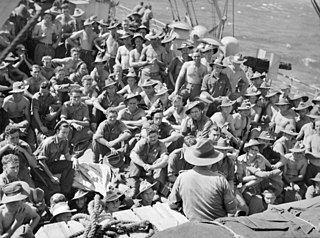
The 36th Battalion was an infantry battalion of the Australian Army. It was originally raised in 1916 as part of the First Australian Imperial Force during World War I. Throughout World War I the battalion served on the Western Front as part of the 9th Brigade, attached to the 3rd Division. Due to heavy casualties amongst the AIF and a decrease in the number of replacements arriving from Australia in 1918, the battalion was disbanded before the war ended in order to reinforce other units in France. The 36th Battalion was re-raised in 1921 as part of the Militia based in Sydney. During World War II the battalion was attached to the 14th Brigade and was initially used in a defensive role as a garrison unit in Australia before being sent to New Guinea in 1942. The 36th Battalion spent most of the 1942–45 period overseas in New Guinea and New Britain where they undertook operations against the Japanese. In June 1945 they were returned to Australia and shortly afterwards the battalion was disbanded.

The 3rd Battalion was an infantry battalion of the Australian Army. Originally raised as part of the First Australian Imperial Force for service during World War I, the battalion formed part of the 1st Brigade, attached to the 1st Division. It was formed shortly after the war broke out and was among the first Australian units to be sent overseas, arriving in Egypt in December 1914. In April 1915 the battalion participated in the Landing at Anzac Cove, coming ashore in the second and third waves. In December 1915 the 3rd Battalion was evacuated from the Gallipoli peninsula and withdrawn to Egypt again, where it took part in the defence of the Suez Canal before being sent to France to fight on the Western Front in March 1916. For the next two and a half years the unit would serve in the trenches in France and Belgium and would take part in many of the major battles fought during that time. In May 1919, following the end of the war, the battalion was disbanded and its personnel repatriated back to Australia.

The 11th Brigade is an Australian Army brigade which currently comprises most Australian Army Reserve units located in Queensland. The brigade was first formed in early 1912 following the introduction of the compulsory training scheme. Later, as part of the 3rd Division and saw action during World War I on the Western Front as part of the First Australian Imperial Force. In the interwar years, the brigade was re-raised with its headquarters in Brisbane.

New Guinea Force was a military command unit for Australian, United States and native troops from the Territories of Papua and New Guinea serving in the New Guinea campaign during World War II. Formed in April 1942, when the Australian First Army was formed from the Australian I Corps after it returned from the Middle East, it was responsible for planning and directing all operations within the territory up until October 1944. General Headquarters Southwest Pacific Area Operational Instruction No.7 of 25 May 1942, issued by Commander-Allied-Forces, General Douglas MacArthur, placed all Australian and US Army, Air Force and Navy Forces in the Port Moresby Area under the control of New Guinea Force. Over the course of its existence, New Guinea Force was commanded by some of the Australian Army's most notable commanders, including Sydney Rowell, Sir Edmund Herring and Sir Leslie Morshead.

The 14th Light Horse Regiment was a mounted infantry or light horse unit of the Australian Army. The unit takes its lineage from units raised as part of the colonial forces of the state of Queensland in 1860 and served during the Second Boer War and World War I. In 1930 it was amalgamated with the 2nd Light Horse Regiment to become the 2nd/14th Light Horse Regiment, a unit that continues to exist as part of the Australian Army today.

The 14th Battalion was an infantry battalion of the Australian Army. Originally raised in 1914 as part of the Australian Imperial Force for service in World War I, the battalion served at Gallipoli initially before being sent to France where it served in the trenches along the Western Front until the end of the war, when it was disbanded. It was raised again in 1921 as a part-time unit of the Citizen Forces based in Victoria. Later, during World War II the battalion was called up for defensive duties to guard against possible Japanese invasion, but in late 1942 it was merged with the 32nd Battalion to become the 14th/32nd Battalion.

The 2nd Health Brigade (2HB) is an Australian Army brigade. The 2nd Brigade was formed in 1903 as a militia infantry formation based in Victoria, the brigade later served during the First World War as part of the Australian Imperial Force, allocated to the 1st Division. During the war, the 2nd Brigade took part in the fighting at Gallipoli, including the Battle of Krithia where it lost almost a third of its strength. Later they took part in the Battle of Lone Pine before being withdrawn back to Egypt in December 1915. Following this the brigade was transferred to the Western Front in France and Belgium where, between March 1916 and the armistice in November 1918, they took part in most of the major Allied operations.
The 11th Division was an Australian Army unit formed during World War II by the renaming of Milne Force in December 1942. Predominately a Militia formation, the division's main role during the war was as a base command headquarters, although elements saw action in New Guinea against Japanese forces during the Finisterre Range campaign and in New Britain. It was disbanded in July 1946.

The 10th Brigade was an infantry brigade of the Australian Army. Originally formed in 1912 as a Militia formation, the brigade was re-raised in 1916 as part of the expansion of the Australian Imperial Force following the end of the Gallipoli campaign. It subsequently saw service on the Western Front in France and Belgium during World War I. After the war it was disbanded but was re-raised in 1921 as a part-time formation based in the state of Victoria. During World War II the brigade was used in a garrison role in Australia before being disbanded in 1942. The brigade is slated to be re-raised as the Army's 'Fires Brigade' to host and operate the Australian Army's High Mobility Rocket System (HIMARS) and National Advanced Surface-to-Air Missile System (NASAMAS)
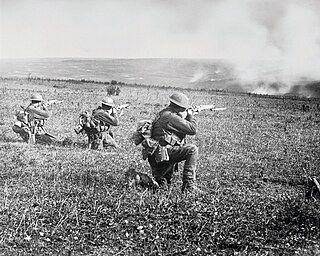
The 12th Brigade was an infantry brigade of the Australian Army. Formed in 1912 as a Militia formation, it was later re-raised in 1916 as part of the all volunteer First Australian Imperial Force that was raised for overseas service during the First World War. The brigade was part of the 4th Division and fought on the Western Front until the end of the war in November 1918. During the inter-war years, the brigade was re-formed in Australia as a part-time unit; during the Second World War, it was mobilised for full-time service, but did not serve overseas, undertaking garrison duties in Australia until 1945 when it was used to raise Timor Force.

The 55th/53rd Battalion was an infantry battalion of the Australian Army which saw active service during World War II. First formed in 1919 during the demobilisation of the Australian Imperial Force, the battalion was an amalgamation of two other units, the 55th and 53rd Battalions. It was disbanded shortly afterwards and remained off the order of battle until 1937 when it was raised as a part-time unit of the Militia, based in Sydney. In 1941, with the expansion of the Australian Army in response to the growing threat of war in the Pacific, the battalion was split and the 55th and 53rd Battalions reformed separately. In late 1942, however, they were amalgamated once more and together went on to participate in the fighting against the Japanese in New Guinea and on Bougainville.
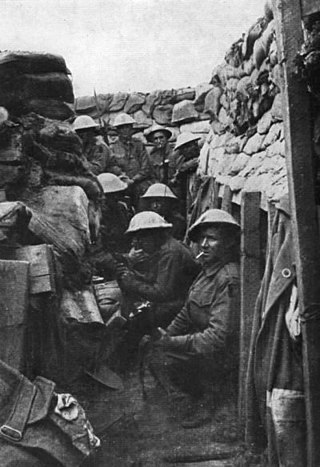
The 53rd Battalion was an infantry battalion of the Australian Army. Raised in 1916 for service during World War I the battalion served on the Western Front until the end of the war, before being briefly amalgamated with the 55th Battalion and then eventually disbanded in 1919. In 1921, the 53rd Battalion was re-raised and in 1927 adopted the title of the "West Sydney Regiment". In 1937 they were once again amalgamated with the 55th, forming the 55th/53rd Battalion.
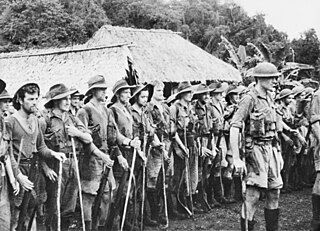
The 30th Brigade was a brigade-sized infantry unit of the Australian Army. Formed in December 1941, as part of the Militia, the unit was raised for service during the Second World War. Established in response to Japan's entry into the war, the brigade's subordinate units were established in several Australian states. Some of these had already been dispatched to New Guinea before the brigade's headquarters was established, although the majority arrived there in early 1942.

The 58th Battalion was an infantry battalion of the Australian Army. It was raised in 1916 for overseas service during World War I and saw action on the Western Front from June 1916 until the end of the war. Following the end of hostilities it was disbanded in 1919; however, in 1921 the battalion was re-raised as part of the part-time Citizens Force and remained in existence until 1942 when it was amalgamated with the 59th Battalion to form the 58th/59th Battalion. That battalion subsequently saw active service in the Pacific against the Japanese during World War II before being disbanded in 1946. After the war, the battalion was re-formed as an amalgamated Citizens Military Force unit, the 58th/32nd Battalion, which was based in Melbourne. This unit remained in existence until 1960 when it was subsumed into the Royal Victoria Regiment.

The 55th Battalion was an infantry battalion of the Australian Army. Raised in 1916 for service during World War I in the AIF the battalion served on the Western Front until the end of the war, before being briefly amalgamated with the 53rd Battalion and then being disbanded in 1919. In 1921, the 55th Battalion (militia) was re-raised and in 1927 adopted the title of the "New South Wales Irish Rifles". This designation was later changed to the "New South Wales Rifle Regiment" in 1930, before they were once again amalgamated with the 53rd, forming the 55th/53rd Battalion in 1937. In October 1941, during World War II, the two militia battalions were delinked and the 55th was later deployed to New Guinea, where they took part in the Kokoda Track campaign, fighting against the Japanese. Poorly prepared and trained, and lacking up to date equipment, they performed above expectations; however, they were amalgamated with the 53rd, which had not fared so well, once more in October 1942. The 55th/53rd subsequently took part in further campaigns in New Guinea and Bougainville before being disbanded in May 1946.

The 42nd Battalion was an infantry battalion of the Australian Army. Raised as part of the Australian Imperial Force (AIF) during the First World War, it was established at Enoggera in December 1915, forming part of the 11th Brigade in the 3rd Division. It subsequently served on the Western Front in France and Belgium in 1916–18 before being disbanded on 22 October 1918. In 1921, the battalion was reformed as part of the Citizens Forces becoming known as the 42nd Battalion. Following the outbreak of the Second World War the battalion held a number of training exercises and camps until 1941, before being mobilised in March 1942 as part of the 29th Brigade, in the 5th Division. It subsequently served in New Guinea fighting against the Japanese during 1943–44 and on Bougainville in 1945, before being disbanded on 7 May 1946. In 1948, it was reformed as part of the re-raised Citizens Military Forces. Today, its lineage is perpetuated by the 31st/42nd Battalion, Royal Queensland Regiment, a unit which continues to serve in the Australian Army Reserve.
The 7th Machine Gun Battalion was a battalion of the Australian Army that was raised for service during World War II. Formed in late 1942 from the machine gun companies of several infantry battalions, the 7th Machine Gun Battalion undertook defensive duties around Port Moresby and Milne Bay during the New Guinea campaign before taking part in the defence of Wau airfield during the Battle of Wau in early 1943. The battalion was returned to Australia in late 1943 and subsequently disbanded in mid-1944.
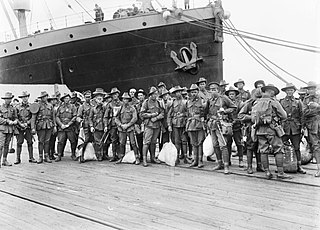
The 5th Machine Gun Battalion was an infantry support unit of the Australian Army. Originally formed in March 1918 for service during World War I as part of the all volunteer Australian Imperial Force, it was one of five such units raised as part of the AIF during the war. The battalion consisted of four machine gun companies, which had previously existed as independent companies assigned mainly at brigade level. The battalion took part in the final stages of the war, seeing action during the Allied defensive operations during the German spring offensive and then the Allied Hundred Days Offensive, which finally brought an end to the war. The battalion was disbanded in mid-1919 during the demobilisation of the AIF following the conclusion of hostilities. During World War II, the battalion was re-raised as part of the Militia in September 1942, and undertook garrison duties in the Torres Strait, until it was disbanded in May 1944.





















